
George C. Hammond
Reviewed by: Philip T. Proctor
It Has Not Yet Appeared What We Shall Be: A Reconsideration of the Imago Dei in Light of Those with Severe Cognitive Disabilities, by George C. Hammond. P&R Reformed Academic Dissertations, 2017. Paperback, 336 pages, $40.00. Reviewed by OP pastor Philip T. Proctor.
How do we understand the doctrine of humanity made in God’s image? How does our imago Dei doctrine encompass those with profound cognitive disability? Pastor Hammond writes of his seminary studies, “a thought occurred to me that filled me with horror: My daughter does not bear the image of God … If the imago Dei is to be found substantively in those things which separate us from animals such as language and intellect; if it is to be found functionally in the ability to exert dominion over the environment and other creatures; or if it is to be found relationally in creating and maintaining intricate human relationships, then it was evident that Rebecca’s life did not fit these criteria” (2).
We tend to include the profoundly cognitively disabled in the definition of imago Dei by exception, which leads to some frightening conclusions. In the first chapter, “The Problem and Its Setting,” the historical understanding of what it means to be human—to bear the image of God—is traced from the Patristic period through the Reformation to the modern disabilities rights movement. In words that sound chillingly Third Reich-ish, the modern and respected scholar Peter Singer is quoted: “If we can put aside these emotionally moving but strictly irrelevant aspects of the killing of a baby [the idea that they are created in God’s image], we can see that the grounds for not killing persons do not apply to newborn infants” (48). Singer’s criteria for the value of human life (consciousness, capacity for interaction, ability to express desire for continued living, etc.) provide the grounds for not merely abortion but for killing the “unhuman” from a wider range. Reacting to this view, Hammond writes at the close of the first chapter, “the church needs a basis for valuing and protecting [the cognitively disabled] that transcends a compassion born of mere sentiment and emotion” (48).
Moving from historical formulations of the imago Dei, to modern “disability theologians,” to exegetical treatment of key passages, Pastor Hammond then offers a holistic definition. In the final section, he gives practical guidance to seminary professors and pastors for teaching and modeling the truth that those with profound cognitive disabilities are as fully made in God’s image as any of us.
Through Pastor Hammond, his daughter Rebecca speaks and teaches the church. This work provides genuinely fresh insight into a problem that, prior to reading it, I hadn’t really considered. While reading, I was challenged and moved by the rigorous academic work that is displayed and the warm father’s heart that is so clearly evident. After reading it, I warmly commend this book to the church as a whole.
November 16, 2025
November 09, 2025
November 02, 2025
October 26, 2025
October 19, 2025
October 05, 2025
Raising Sexually Faithful Kids and
Parenting Boys and Girls in a Gender-Confused World
September 28, 2025
© 2025 The Orthodox Presbyterian Church